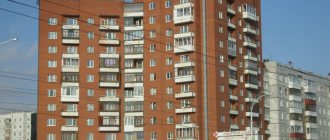The “hungry” crisis market continues to absorb construction companies.
The state is so actively solving the problem of defrauded shareholders that the developers themselves need protection...
“More than 2.5 thousand Russian developers were liquidated in 2015. The number of bankruptcies in the housing construction sector has increased 5 times. The disappointing trend, according to the forecasts of the Construction Industry Rating Agency, will continue in 2021.”
In the wake of the crisis, no one is immune from bankruptcy. Even the most reliable developer with many years of experience and an impeccable reputation may not be able to cope with the debt load and be on the verge of liquidation.
How should developer representatives behave in a critical financial situation? Try with all your might to stay afloat, attracting new investments or declare the company bankrupt?
The main reasons for the bankruptcy of construction companies
Isolated cases of “false” bankruptcies of unscrupulous organizations force citizens to measure all developers with the same yardstick.
But the developer is different from the developer: scammers, of course, are not asleep, but the overwhelming majority of trustworthy companies in the construction market are. And if the former withdraw assets and are liquidated intentionally, then the latter, due to various circumstances, are faced with business risks and intractable financial problems. The main reasons for the bankruptcy of “decent” developers include rising prices for building materials and contract work, an increase in fees and tariffs against the backdrop of a decrease in the purchasing power of Russians, and additional costs associated with the need to insure shared construction. Most companies are forced to repay foreign currency loans, despite a sharp jump in the exchange rate.
The above reasons lead to a long “freeze” of construction and even greater costs. It is becoming more and more difficult to attract investments, the developer finds himself in a web of debt, deadlines are missed, and shareholders and creditors become increasingly active, sending complaints to the authorized bodies and stating their claims in massive lawsuits.
The optimal way out of the debt crisis: attracting investment or bankruptcy?
Examples of unsuccessful bankruptcies of some companies, their complete ruin, and even criminal prosecution of managers and controlling persons, covered in the media, are firmly “imprinted” in the minds of business representatives.
Therefore, developers are trying to avoid bankruptcy and are looking for more and more new sources of financing. Attracting investment is indeed the way out. But not on enslaving terms. Investors in times of economic instability are extremely cautious, and if they invest despite numerous risks, then in such a way that these risks are justified. As a result, the problematic organization buries itself as deeply as possible into a debt hole. He loses his last chance of salvation and is left with nothing.
Therefore, you should not delay bankruptcy. This is the only opportunity to get rid of debts and creditor claims without going beyond the law. In this case, you can not only liquidate, but also save the company.
Benefits of Bankruptcy
Bankruptcy gives you the opportunity to:
- maintain control over the company;
- secure valuable financial assets;
- “cleanse” the enterprise of doubtful debts;
- extend and restructure loans and borrowings;
- obtain a moratorium on creditor claims;
- be freed from seizure of property;
- suspend collections under enforcement documents.
As a result, the company can restore its financial capabilities or be liquidated, while retaining valuable assets.
Why is it important for a developer to be the first to file bankruptcy?
If shareholders and other creditors are the first to declare bankruptcy of the developer, control over the organization may pass into the hands of “unfriendly” persons, and its management may be completely removed from the management of the company.
By initiating a bankruptcy procedure in a timely manner, a construction organization completely eliminates the risks of seizure of valuable assets and any forms of unfriendly influence. Full control over the company remains in the hands of management. A loyal manager, “authoritative” voting rights at creditors’ meetings, a “managed” committee of creditors – these are the advantages that representatives of the developer can receive by being the first to file for bankruptcy.
Signs of bankruptcy of a developer
Bankruptcy refers to financial insolvency and the inability to make payments to creditors recognized by the arbitration court. The first sign of bankruptcy is that a case is opened and it is recognized as an insolvent entity.
For a trial to begin, the developer must have signs of insolvency:
- Amount of debt. For legal entities – from 100 thousand rubles, for individuals – from 10 thousand rubles. The amount is calculated as the total amount of debt to various creditors, even if the volume of each of them does not independently reach the minimum. If the minimum threshold is not reached, the court does not begin proceedings;
- Late payment. If payment has not been made within three months after the due date, the creditor has every right to appeal to the judicial authorities;
- Impossibility of collection. If the debt cannot be collected within 30 days.
All the features of a developer’s bankruptcy are described in this video:
If signs are noticed by management, all founders and participants must be immediately informed.
Features of the bankruptcy procedure for a developer
When submitting an application to the court, it is imperative to indicate that the person is a developer; if the court does not find out this before, it will find out about it after the initiation of the case, and the procedure will take place using the rules for the developer.
Based on the latest amendments, the procedure includes the following features:
- Start of liquidation; this can happen by a voluntary decision of the developer or due to ruin;
- Filing an application to court;
- Obtaining a decision from the judicial authorities and starting the monitoring procedure;
- Transfer of the case to the place of residence of the majority of shareholders or to the location of the bankrupt property;
- Establishing a prohibition for the owner of a land plot to transfer or lease the property to anyone else;
- Notifications to shareholders within five days about the fact of the initiation of a bankruptcy case;
- Possible demands of shareholders to transfer finished apartments from the debtor’s balance sheet, if any, and to pay off the existing debt;
- Transfer of real estate to shareholders if the amount they want to receive as compensation exceeds the cost of the property by no more than 5%;
- Liquidation of a legal entity.
In addition, the transaction in relation to the construction project is considered invalid or not concluded, and the real estate is transferred to economic management. The state registers the transfer of ownership of real estate.
If the developer declared himself bankrupt intentionally
Intentional bankruptcy is often carried out by the manager himself with planned actions. This helps to confuse everyone involved, from employees and creditors to competitors.
What can shareholders demand?
This type of ruin is illegal and criminally punishable in accordance with the legislation of the Russian Federation.
The main purpose of deliberate bankruptcy is to delay payments or avoid paying them altogether. They also do this to remove valuable property and assets. Of course, first the developer creates a plausible picture in the form of huge investments in construction, and after declaring bankruptcy he creates a residual enterprise.
It is in such an enterprise that you can leave personnel, debt and property that is of no value. This type of bankruptcy represents the illusion of insolvency, in order to achieve the main goal - the ruin of the company in the eyes of creditors.
The process of deliberate bankruptcy and the method of not completing construction
One of the options for ruining a future fake bankrupt is the use of contractors. Contractors are used in the literal sense of the word, since the developer knows that he will not pay them.
Further, he announces that he cannot pay for the services provided, which significantly delays the construction process. The process is being delayed and work is gradually being suspended. After everything, the debtor is officially declared bankrupt.
In this case, the contractor is in the same situation as the shareholder. He invested money, effort and time in construction and was not rewarded for it. On some construction projects, contractors are bankrupt in a conspiracy, which gives them an advantage in making claims before the equity holder.
If there is no collusion, the claims of shareholders and employees are considered in accordance with existing rules. If the contractor can be informed about the impending fraud and take appropriate action, including dismissal from work, then the shareholder does not know anything until the last minute.
That is why a shared developer should be carefully selected from those provided, having studied in detail the information about each.
Two strategic paths: resuscitation or liquidation?
When planning bankruptcy, you need to decide on a strategy.
Two essentially opposite paths are possible: liquidation of the company with exclusion from the Unified State Register of Legal Entities or resuscitation of its activities (restoration of solvency) during bankruptcy restoration procedures - by attracting investments, measures aimed at rationalizing production, restructuring accounts payable, etc. When it is impractical or impossible to maintain a legal entity, the bankruptcy procedure is used to preserve valuable assets, pay off accounts payable at a discount, legally write off debts as impossible to collect, and withdraw assets within the framework of the law. However, a liquidation strategy does not always mean the collapse of a business. Representatives of the developer have the opportunity to create a new enterprise.
Nuances of the bankruptcy procedure for a developer
The nuances of bankruptcy of developers include:
- special rules for protecting the interests of shareholders;
- the possibility of settlements with creditors, both in money and real estate (including unfinished construction projects);
- advantage of the register priority of shareholders over bankruptcy creditors;
- the possibility of considering the case both at the place of registration of the developer and at the location of the majority of construction participants.
In general, the bankruptcy procedure for a developer is, in most respects, similar to the insolvency procedure for any other legal entity.
Features of the bankruptcy procedure for a developer
Voluntary or forced bankruptcy procedure includes several stages. Voluntary declaring a developer bankrupt is possible on the basis of a corresponding decision of the arbitration court. An appeal to the court can be filed by a bankruptcy creditor, who must provide information about the bankruptcy of a specific construction organization. If a positive decision is made to declare the developer bankrupt, the following basic actions are performed (Article 28 of Law No. 127-FZ):
- Appointment of a bailiff to organize a liquidation commission.
- Submitting a notice of bankruptcy of a legal entity to the tax authority in form No. P15001.
- Transferring information about employees of a bankrupt company to the employment service 3 months before the liquidation of the organization.
- Informing employees about dismissal at least 2 months before liquidation.
- Publication of information about the bankruptcy of a construction company in government publications.
- Distribution of property and funds of a bankrupt developer in the appropriate manner established by law.
- Receipt by the contractor from the Federal Tax Service of an extract from the Unified State Register of Legal Entities confirming the final liquidation of the enterprise.
The latest amendments to the Federal Law “On Amendments...” No. 210-FZ of July 12, 2011, introduced into Law No. 127-FZ, and Art. 17 and 223 of the Arbitration Procedure Code of the Russian Federation, regarding the establishment of facts of bankruptcy of construction organizations, establish the following features of the bankruptcy procedure for a developer:
- After receiving a positive court decision to begin the monitoring procedure, the bankruptcy case is transferred for consideration to the place of residence of the majority of participants in shared construction or to the location of the bankrupt developer.
- Issuance of a resolution prohibiting the transfer of a land plot to other persons or the rental of an object.
- Participants in shared construction must be informed about the start of the developer's bankruptcy procedure within 5 days.
- Finished apartments on the balance sheet of the bankrupt debtor are transferred to shareholders.
- The amount of compensation that a DDU participant wishes to receive from a bankrupt company cannot exceed the cost of the object by more than 5%.
What do shareholders have the right to demand?
Shareholders can demand:
- money (the amount of compensation consists of the amount under the contract and compensation for damage incurred)
or
- residential premises due to them.
Important:
- The decisive point in the issue of including shareholders in the register of creditors is compliance with the deadlines for submitting monetary claims, which are thirty days from the date of publication of the message about the beginning of the bankruptcy procedure, and two months from the date of publication of the message about declaring the debtor bankrupt. If the shareholder missed the deadlines established by law, the likelihood of satisfying his claims tends to zero.
- Another important point is the state registration of the agreement for participation in shared construction, without which inclusion of the shareholder’s requirements in the register is almost impossible.
Procedure in case of bankruptcy of a developer
An application for inclusion of claims in the register of creditors is submitted to the bankruptcy trustee. The application may indicate a requirement for the transfer of ownership of the apartment or for the return of funds.
If the house has already been put into operation, the application indicates a requirement for recognition of ownership. In this case, it is necessary to apply to the arbitration court.
When the house is not completed, it will be built to completion. Funds for this are taken from the compensation fund, a special fund of a constituent entity of the Russian Federation or another developer who will acquire the rights to the property and assume the obligations of the bankrupt construction company. Funds can also be allocated from the housing cooperative fund. In this case, you will need to wait until construction is completed. Next, the procedure will be the same as expected - the house will be put into operation, and the shareholders will enter into property rights.
If it is not in your best interest to wait until construction is completed, you can request the funds back. However, this is only permissible until the bankrupt developer’s obligations are transferred to another construction company.
Response to the equity holder’s demands: how does bankruptcy solve the developer’s debt problems?
Repayment of the claims of shareholders in bankruptcy proceedings can be made in one of the following ways:
- By transferring an unfinished construction project. This method involves the creation of a housing construction cooperative by shareholders and the transfer of an unfinished house to its management. Further construction must be carried out by citizens at their own expense.
- By recognizing rights to residential premises. This method only applies if you have permission to put the house into operation and a signed transfer deed.
- By attracting a new developer to build a house. All property and obligations of the bankrupt developer are transferred to another legal entity.
If the transfer of housing is impossible, the claims are converted into cash equivalent and are repaid after the sale of the property in accordance with the established priority.
Construction will not take place
Also, the reason may lie in the behavior of shareholders. Bankruptcy proceedings may be initiated by an arbitration court, provided that the total claims against the debtor, a legal entity, amount to at least 300 thousand rubles. This general formulation also applies to bankruptcy of real estate developers. Compare the average cost of an apartment in any region of Russia and the amount of 300 thousand rubles. Often, buyers/shareholders use the right to submit such an application as a tool to influence the developer.
In general, the bankruptcy procedure is not always of a sharply negative nature for the debtor. In cases where the decision on the fate of the business has already been made by its owner, one way or another some preparation will be carried out. The principles of the institution imply consequences for a debtor declared bankrupt in the form of the sale of property and subsequent liquidation. In this case, the amount of satisfaction received from creditors (at least the last priority) is usually less than the amount of debt. Hold the manager accountable? Criminal liability can only bring moral satisfaction. The importance of civil liability cannot be overestimated, but the amount of satisfaction that can be received from the person controlling the debtor may turn out to be unpredictably small if he, as an individual, is declared bankrupt.
This is not only about such large business participants as the SU-155. Many other developers are in various bankruptcy procedures. It is not only ordinary citizens who suffer. This type of bankruptcy combines social and commercial aspects.
Proceedings in this type of case are complicated by the presence of specific subjects in a bankruptcy case—construction participants. The provisions of the law are not without a social component, which is why cases of bankruptcy of developers can be considered at the location of the real estate object or even at the place of residence/location of the majority of construction participants.
To protect the interests of construction participants, additional interim measures may be introduced, for example, a ban on Rosreestr to register any lease agreements for the land plot on which construction is being carried out. Such measures may be introduced at the initiative of the applicant or another person participating in the bankruptcy case.
During the bankruptcy of developers, there may be several categories of creditors, including creditors who have the right to make a monetary claim, as well as creditors with claims for the transfer of the direct result of construction - residential premises.
When submitting an application to include a claim in the register, it is important to determine what type of claim it will be. If the construction of a house is completed, the construction participant has the right to submit to the arbitration court a demand for the transfer of residential premises and inclusion of his claim in the register of claims for the transfer of residential premises, which is essentially part of the register of creditors' claims. In this case, the demand is made, of course, in relation to a very specific premises (the obligation to transfer which arose with the debtor under the contract).
If creditors have claims not related to the transfer of residential premises, then the claims are declared as monetary. This typically applies to contractors, suppliers and other entities that deal with the developer in the ordinary course of business. In addition, monetary claims are in the form of a penalty for violating the deadlines for the transfer of residential premises, as well as claims related to causing damage.
The bankruptcy law stipulates that the claims of citizens participating in construction are satisfied in the third place, and in the fourth place - the claims of other creditors. However, in the third place, after satisfying the monetary claims of citizens participating in the construction, the demands of the bank that issued a guarantee for the proper fulfillment by the developer of the obligations to transfer residential premises under the DDU, which passed to him as a result of the fulfillment of the obligations secured by the guarantee, are subject to satisfaction.
Satisfaction of creditors' demands can occur in different ways. Under certain conditions, the developer's rights to the unfinished construction project and land plot are transferred to a housing construction cooperative or other specialized consumer cooperative as compensation for claims for the transfer of residential premises and monetary claims. Also, construction participants who have a monetary claim may be given residential premises as compensation. In some cases described in the law, the construction project is sold and the proceeds are distributed in order of priority among creditors.
As a result of the developer being declared bankrupt, the legal entity must be liquidated. At the same time, if as a result of special bankruptcy procedures the financial condition of the developer is restored, then it is possible that part of the rights to the business will pass to the investor under the relevant agreements.
From January 1, 2014, developers are required to additionally ensure the fulfillment of their own obligations to equity investors. Such additional security is manifested in the form of liability insurance for the developer in favor of equity investors or in the form of a bank guarantee also in favor of potential creditors.
In this regard, creditors whose claims are included in the register can apply directly to the insurer for payment of compensation. Moreover, if the claims are not satisfied in full by the insurer, then the remaining balance is not “settled” and the debtor’s obligation does not terminate. At the same time, the bankruptcy trustee reduces the size of the creditor's claim by the amount of satisfaction received.
If there is a bank guarantee, the creditor may ask the bank that issued the guarantee to satisfy the requirements in the amount included in the register. The rules for the remainder of the debt are the same as in the case of the insurer.
However, these mandatory requirements came into force relatively recently, and the average implementation period for a construction project is a year or more. In this case, the law does not have retroactive force, so there are still quite a lot of construction participants whose rights are not protected in such additional ways. They can satisfy their claims under the “classic” scheme of bankruptcy law.
What if there are too many creditors and too few financial resources? Payment procedure
Individual shareholders who demand a return of invested funds will receive their hard-earned money only in the third place.
The priority right to receive compensation is given to employees of the debtor organization, as well as persons to whom the developer caused harm to life or health. It happens that after paying wages and severance pay to bankrupt employees, there is no longer enough money to fully pay the shareholders’ claims. Investors and other creditors are included in the fourth priority, but claim 60% of the proceeds from the sale of the property.
During the bankruptcy procedure, the developer pays off with creditors based on available opportunities. There may not be enough money for everyone. However, upon completion of the bankruptcy procedure, the developer is considered free of debt obligations.
The order of satisfaction of creditors' claims in the event of bankruptcy of a developer
According to Article 201.9 of 127-FZ, in case of bankruptcy of a developer, a slightly different procedure for repaying creditors’ claims is applied. According to this legal norm, shareholders have priority over other creditors when repaying claims. Art. 201.9 127-FZ provides for 4 queues of creditors (instead of three in the standard case).
According to paragraph 1 of Art. 201.9 127-FZ, creditors’ claims are repaid in the following sequence:
- The first step involves paying off the claims of citizens to whom the debtor has obligations to pay compensation for harm caused to life and health.
- The second stage involves calculations for the payment of severance pay and wages of employees.
- The third stage includes monetary claims of citizens participating in construction, claims of the Fund, and claims of shareholders for compensation of losses.
- The fourth stage involves settlements with other creditors.
How to avoid liability for claims of creditors and shareholders?
Managers, founders and other controlling persons of the developer may be brought to subsidiary liability, which provides for the settlement of the organization's debts with personal money and property, administrative liability in the form of unaffordable fines, as well as criminal liability for violations of the bankruptcy law with a maximum penalty of 6 years of imprisonment freedom.
In practice, cases of prosecution are quite rare due to the complexity of building an evidence base.







